Serving 781 students in grades Kindergarten-8, Walton Charter Academy ranks in the bottom 50% of all schools in Michigan for overall test scores (math proficiency is bottom 50%, and reading proficiency is bottom 50%).
The percentage of students achieving proficiency in math is 21% (which is lower than the Michigan state average of 34%). The percentage of students achieving proficiency in reading/language arts is 31% (which is lower than the Michigan state average of 45%).
The student:teacher ratio of 19:1 is higher than the Michigan state level of 17:1.
Minority enrollment is 96% of the student body (majority Hispanic), which is higher than the Michigan state average of 37% (majority Black and Hispanic).
Quick Stats (2025)
- School Type: Charter School
- Grades: Kindergarten-8
- Enrollment: 781 students
- Student:Teacher Ratio: 19:1
- Minority Enrollment: 96%
- Overall Testing Rank: Bottom 50% in MI
- Math Proficiency: 21% (Btm 50%)
- Reading Proficiency: 31% (Btm 50%)
- Science Proficiency: 20-24% (Btm 50%)
- Source: National Center for Education Statistics (NCES), MI Dept. of Education
Top Rankings
Walton Charter Academy ranks among the top 20% of public schools in Michigan for:
Category
Attribute
Diversity
Percent Eligible For Free Lunch
School Overview
Walton Charter Academy's student population of 781 students has stayed relatively flat over five school years.
The teacher population of 42 teachers has stayed relatively flat over five school years.
School Type
Grades Offered
Grades Kindergarten-8
Total Students
781 students

Gender %
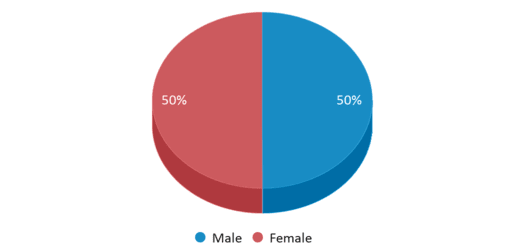
Total Classroom Teachers
42 teachers

Students by Grade
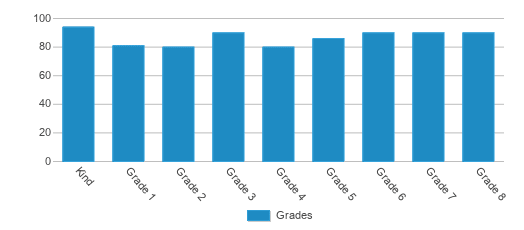
School Rankings
Walton Charter Academy ranks within the bottom 50% of all 3,069 schools in Michigan (based off of combined math and reading proficiency testing data).
The diversity score of Walton Charter Academy is 0.58, which is more than the diversity score at state average of 0.56. The school's diversity has stayed relatively flat over five school years.
Overall Testing Rank
#2202 out of 3069 schools
(Bottom 50%)
(Bottom 50%)

Math Test Scores (% Proficient)
21%
34%
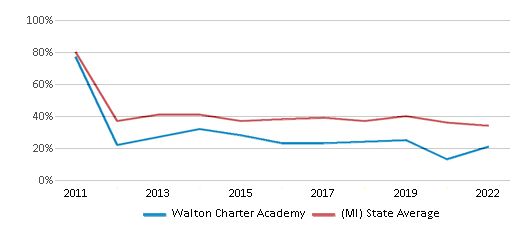
Reading/Language Arts Test Scores (% Proficient)
31%
45%
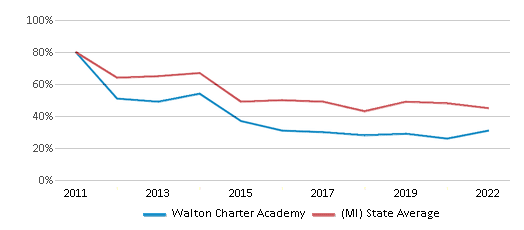
Science Test Scores (% Proficient)
20-24%
38%
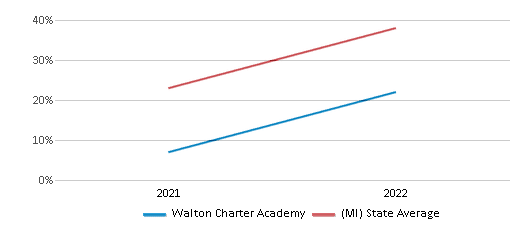
Student : Teacher Ratio
19:1
17:1
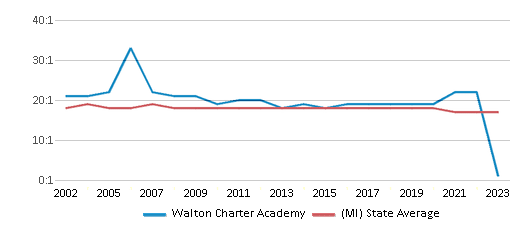
American Indian
n/a
1%
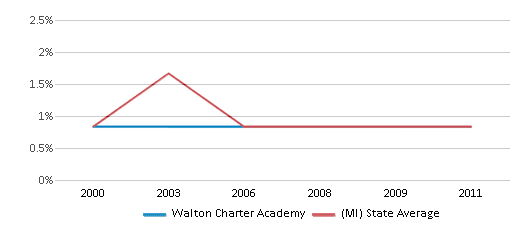
Asian
2%
4%
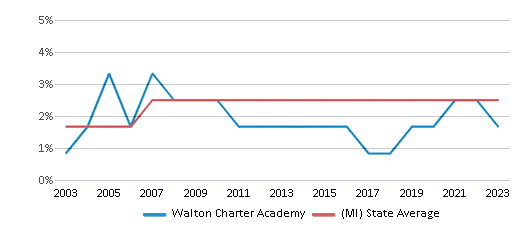
Hispanic
58%
9%

Black
28%
18%
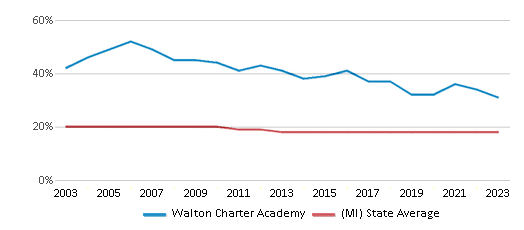
White
4%
63%
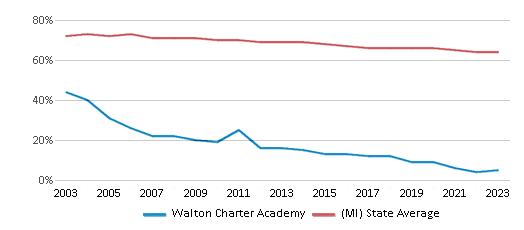
Hawaiian
n/a
n/a
Two or more races
8%
5%
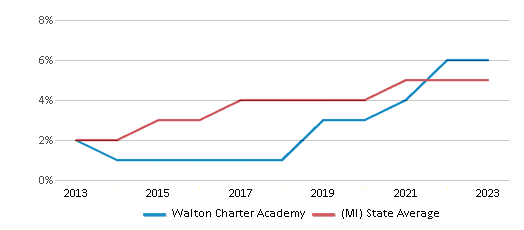
All Ethnic Groups
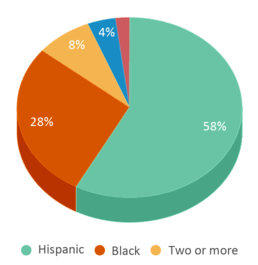
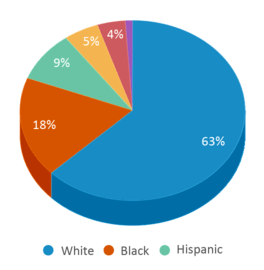
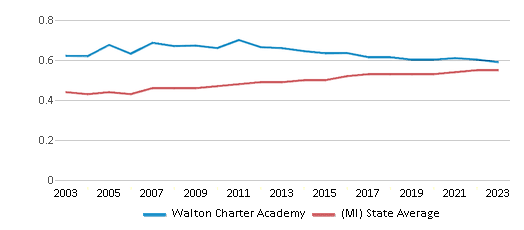
Participates in the National School Lunch Program (NSLP)
Yes
Eligible for Free Lunch
87%
50%
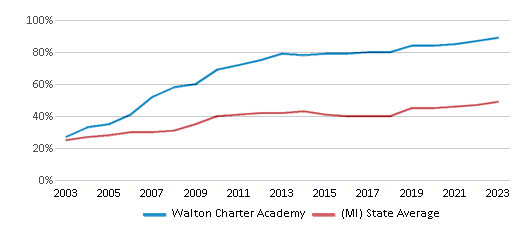
Eligible for Reduced Lunch
6%
4%
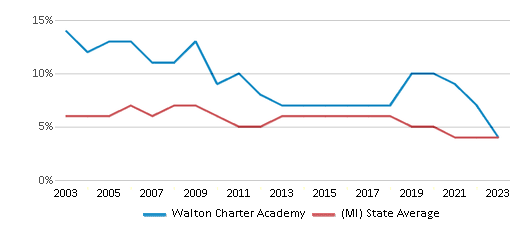
School Statewide Testing
School District Name
Source: National Center for Education Statistics (NCES), MI Dept. of Education
Profile last updated: 02/09/2025
Frequently Asked Questions
What is Walton Charter Academy's ranking?
Walton Charter Academy is ranked #2202 out of 3,069 schools, which ranks it among the bottom 50% of public schools in Michigan.
What percent of students have achieved state testing proficiency in math and reading?
21% of students have achieved math proficiency (compared to the 34% MI state average), while 31% of students have achieved reading proficiency (compared to the 45% MI state average).
How many students attend Walton Charter Academy?
781 students attend Walton Charter Academy.
What is the racial composition of the student body?
58% of Walton Charter Academy students are Hispanic, 28% of students are Black, 8% of students are Two or more races, 4% of students are White, and 2% of students are Asian.
What is the student:teacher ratio of Walton Charter Academy?
Walton Charter Academy has a student ration of 19:1, which is higher than the Michigan state average of 17:1.
What grades does Walton Charter Academy offer ?
Walton Charter Academy offers enrollment in grades Kindergarten-8
What school district is Walton Charter Academy part of?
Walton Charter Academy is part of Walton Charter Academy School District.
School Reviews
2 3/9/2007
The quality of education at Walton Charter Academy in Pontiac is a disgrace. My children attended Pontiac
Public Schools prior to enrolling with Walton Academy.
Their test scores on the standardized testing has decreased drastically over the past 2 years. There's
no extracurricular activities to keep the students busy
and interested enough to look forward to coming to school sports, i.e. I've found that the students are not
top priority for the principal or teachers. My 6th grader has had a total of 7 new teachers since 5th grade. I've also found that those in authority
have no problem solving skills. They would rather suspend and expell students instead of finding resolution to problems. How can our students learn if their not in school? The principal does not find a problem with the big turnover in faculty (teachers).
I feel as though my children are not getting the quality
education they deserve and are entitled to. All the things affect academic progress, moral, and behavior.
d
Review Walton Charter Academy. Reviews should be a few sentences in length. Please include any comments on:
- Quality of academic programs, teachers, and facilities
- Availability of music, art, sports and other extracurricular activities
Recent Articles

What Is A Charter School?
Explore the world of charter schools in this comprehensive guide. Learn about their history, how they operate, and the pros and cons of this educational innovation. Discover key facts about charter schools, including admission policies, demographics, and funding, as well as what to look for when considering a charter school for your child.

10 Reasons Why High School Sports Benefit Students
Discover the 10 compelling reasons why high school sports are beneficial for students. This comprehensive article explores how athletics enhance academic performance, foster personal growth, and develop crucial life skills. From improved fitness and time management to leadership development and community representation, learn why participating in high school sports can be a game-changer for students' overall success and well-being.

February 05, 2025
Understanding the U.S. Department of Education: Structure, Impact, and EvolutionWe explore how the Department of Education shapes American education, from its cabinet-level leadership to its impact on millions of students, written for general audiences seeking clarity on this vital institution.









